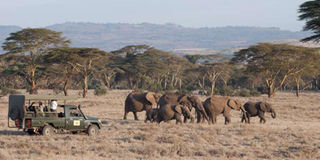Kenya, Tanzania launch aerial count of elephants and buffaloes

Tourists watch a herd of elephants at the Lewa Wildlife Conservation area in Kenya. Wildlife stakeholders have launched a 14-day aerial count of elephants and buffaloes in the Serengeti-Maasai Mara ecosystem. PHOTO | FILE
What you need to know:
- The count will inform future interventions to shield the mammals from threats linked to human activity and climatic stresses.
- Kenya and Tanzania are conducting the elephant census concurrently in line with a bilateral agreement to enhance cross border protection.
Wildlife stakeholders on Tuesday launched a 14-day aerial count of elephants and buffaloes in the Serengeti-Maasai Mara ecosystem.
The count, conducted by the Kenya Wildlife Service (KWS), Tanzania Wildlife Research Institute, Narok County Government and World Wildlife Fund for Nature (WWF) is aimed at generating data to improve efforts to protect elephants and buffaloes amid multiple threats like poaching and increased human activity.
CLIMATIC STRESSES
KWS ecological monitoring director Shadrack Nkene said the count is being carried out in Kenya and Tanzania and will inform future interventions to shield the mammals from threats linked to human activity and climatic stresses.
“The core aim of the headcount on elephants and large mammals is to assess the population trends in relation to numerous challenges like poaching, droughts and shrinking habitats,” said Dr Nkene, who is leading a team of technicians in the count.
BORDER PROTECTION
He said Kenya and Tanzania are conducting the elephant census concurrently in line with a bilateral agreement to enhance cross border protection.
“The results will help us to establish if they are on the increase, or decreasing. We will also establish the human activities in the conservation areas,” he added.
The 2014 aerial survey shows an increase from 2,058 elephants in 1986 to 7,535 in 2014, in the world famous Maasai Mara-Serengeti ecosystem that straddles the Kenya/Tanzania border.
ELEPHANT POPULATION
A total of 192 elephant carcasses were counted during the survey, of which 117 were in Kenya and 75 in Tanzania.
The ratio of carcasses to live elephants was 2.5 per cent which is well within the normal range of 2.8 per cent of what a stable or increasing elephant population would exhibit in this kind of survey.
WWF director Jared Bosire said the count used two aircraft, covering an area of 12,000 square kilometres. He said in 2014, more than 8,045 elephants were counted in the ecosystem.




